
Dear Clients:
What a difference a year makes, thank goodness! The S&P 500 had a total return of 8.7% in the second quarter (Q2-2023) and 16.9% in the first-half of 2023. Client equity portfolios also staged a solid comeback in the first-half of 2023, which we think was an impressive result given the significant headwinds encountered by active, value managers, which we’ll explore in further detail. Further, though past performance is no guarantee of future results, history can be a useful guide and CFRA Research tells us following a first-half gain in excess of 10%, the S&P 500’s second-half return typically nearly doubled its normal 77-year average second-half return (8.0% vs. 4.5%) and delivered a 12-percentage point improvement in its frequency of positive second-half returns (83% vs. 71%).
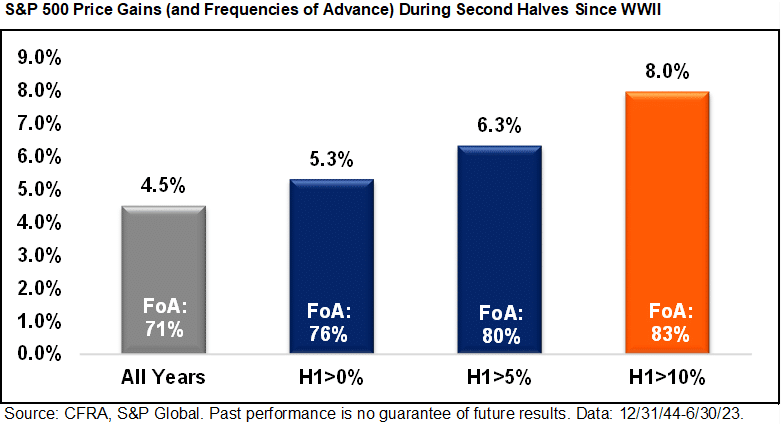
Taking a walk down “Memory Lane” sometimes brings back painful memories, but can also reinforce important lessons. In our quarterly update in July 2022, we noted the first half of 2022 was the worst start to a year for the U.S. stock market in over 50 years. As it turned out, 2022 would be the worst year for stocks since the depths of the Global Financial Crisis/Great Recession in 2008 (4th worst for the S&P 500 since 1945) and worst year for bonds ever.
There was drama galore in 2022. Inflation started the year at a 40-year high, driven by excessive monetary stimulus from the Federal Reserve (“Fed”) and $5 trillion of COVID-relief fiscal stimulus. The Fed slashed short-term interest rates to 0% at the start of the pandemic in early 2020 and restarted “quantitative easing (“QE”), purchasing $80 billion of U.S. Treasury Bonds and $40 billion of mortgage-backed securities on the open market each month, which kept longer-term interest rates low. This caused money supply to explode to the upside, which combined with supply chains that were still recovering from the pandemic to send prices soaring. Russia’s invasion of Ukraine added fuel to the inflation fire.
The Fed and its 400 Ph.D. economists predicted with great confidence as recently as late 2021 that elevated inflation readings were due to “transitory” factors that would soon self-correct. When it became apparent this wasn’t to be, this same group slammed on the brakes, aggressively changing course to “quantitative tightening” and increasing short-term interest rates from 0% at the start of the year to 4.25%-4.50% in a rapid-fire series of jumbo bumps (increments of 0.25% (March), 0.50% (May), 0.75% (June), 0.75% (July), 0.75% (September), 0.75% (November) and 0.50% (December)).
The year was so bad, Bloomberg said, “one bad year in the stock market has turned Wall Street strategists into bears after two decades of bullishness.” In fact, the average forecast for the 17 firms Bloomberg tracked called for the S&P 500 to decline in 2023, “the first time the aggregate prediction has been negative since at least 1999.” Further, the best-case forecast called for the S&P 500 to finish 2023 10% higher, while the worst-case predicted a 17% fall, a divergence not seen in over a decade and indicative of a debate over how much and how fast the Fed would continue to raise rates and whether the coming recession would be “shallow” or more akin to the Great Recession.
In summing up 2022, we said:
The pain is real. Pessimism is high. Fear is extreme and understandable. We’re heavily invested alongside you and feel the same emotions. Still, while there are undoubtedly more shoes to drop in 2023 that could cause stocks and bonds to drop further, we believe 1) much of the bad news has already been priced into the market, 2) the regime change from 0% interest rates will finally force investors to focus on company fundamentals and stock valuations, which is how we’ve invested for the past what will be 48-years on May 1, 2023 and 3) it is difficult times like these that present opportunities for long-term investors in a world obsessed with short-term results.
Fast forwarding to 2023, the Fed continued to hike interest rates, raising its target for federal funds by 0.25% at each of its meetings on February 1, March 22 and May 3 (5.00% to 5.25%). In May 2020, “headline” inflation as measured by the Consumer Price Index (CPI) was barely positive at 0.1% (year-over-year increase). Just over two years later (June 2022), CPI peaked at 9.1%, the largest yearly increase since the early 1980s. Who knew the CPI would decline in each of the next eleven months to 4.0% in May 2023? According to Bespoke Investment Group, the 5.1% decline in the CPI was the largest trailing 12-month fall since the Global Financial Crisis/Great Recession. This rapid decline gave the Fed “cover” to at least temporarily pause its campaign to fight inflation by raising rates, which had gone on for ten consecutive meetings.

If we told you in March of 2022 the Fed would aggressively increase short-term interest rates from 0% to 5% over the next 14-months, the conventional wisdom would be stocks and the economy would both be pummeled. As is often the case, conventional wisdom would be wrong. In fact, the S&P 500 had a total return of 4.3% from the start of the Fed’s campaign to fight inflation by raising interest rates (March 16, 2022) through June 30, 2023. In addition, the U.S. economy continues to show surprising vigor, with the labor market remaining robust and first quarter of 2023 gross domestic product (GDP) growth recently revised to 2% (from a previously reported 1.3%).
As we’ve stated time and again, the financial markets and economy are impossible to predict due to literally thousands of interrelated factors, even if you have perfect insight into some of the primary inputs like interest rates.
Last year at this time, the S&P 500 had plunged 16.4% in Q2-2022 and 20.6% in the first-half of 2022. In our Q2-2022 Client Letter we shared data from Bespoke Investment Group, which showed the first-half of 2022 was just the eighth time since WWII when the S&P 500 dropped 20%+ in a two-quarter span. Further, the S&P 500 was up the following quarter in six out of the prior seven occurrences (average gain 8.5%) and the following half- (21.5%) and full-year (31.5%) all seven times. It was a very dark time and things certainly didn’t feel very good, but we advised “Don’t get shook. If history is any guide, and there is no guarantee it is, it’s not uncommon for stocks to have sharp rebounds following horrible half-years like the one we just experienced.”
While stocks have indeed rebounded nicely, the magnitude of improvement has actually been below average. As you can see in the updated table below from Bespoke, the S&P 500 dropped an additional 5.3% in the following quarter and rose 1.4% in the next half-year and 17.5% in the next year. Thus, we don’t think the current rebound is a case of “too far, too fast.”
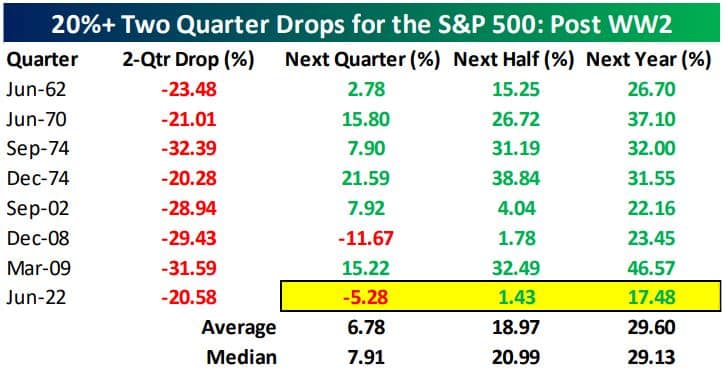
The S&P 500 had a very strong first-half of 2023, but it was actually a case of a small handful of mega-capitalization technology stocks doing exceptionally well, while the vast majority of stocks posted “okay, but not spectacular” returns. Recall the S&P 500 is a capitalization-weighted index, which means the performance of stocks with the largest market capitalizations have a much greater impact on index performance than the performance of stocks with smaller market capitalizations.
The table below lists first-half 2023 and Q2-2023 performance for the S&P 500 as well as various sub-indices. As you can see, while the S&P 500 posted a total return of 16.9% in the first-half of 2023, the S&P 500 (Equal Weight—all 500 stocks having same weighting for calculating index performance) generated less than half the return (7.0% vs. 16.9%). In fact, according to Strategas the 9.9% performance difference between S&P 500 and S&P 500 (Equal Weight) was the biggest since 1999, illustrating both the “narrowness” of the market’s advance and the significant headwind “active” managers faced. Additionally, “Growth” trounced “Value” in the first-half of 2023, creating a “double whammy” for active, value managers like us.
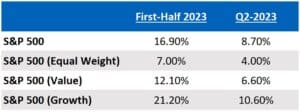
Taking a deeper dive into the extraordinarily “top-heavy” nature of the S&P 500’s advance, according to Bespoke just 30 of the S&P 500 stocks accounted for more than 95% of the gain in the first-half of 2023 (meaning the other 470 stocks accounted for less than 5% of the H1-2023 gain). As shown in the table below, Apple (market capitalization recently crossed $3 trillion, larger than the entire market capitalization of the Russell 2000) alone accounted for about 18% of the gain in the first-half of 2023, with Microsoft and NVIDIA accounting for 14.4% and 13%, respectively. Adding Amazon, Tesla, Meta Platforms and Alphabet, this group of seven mega-capitalization technology stocks accounted for about three-quarters of the gain in the first-half of 2023.
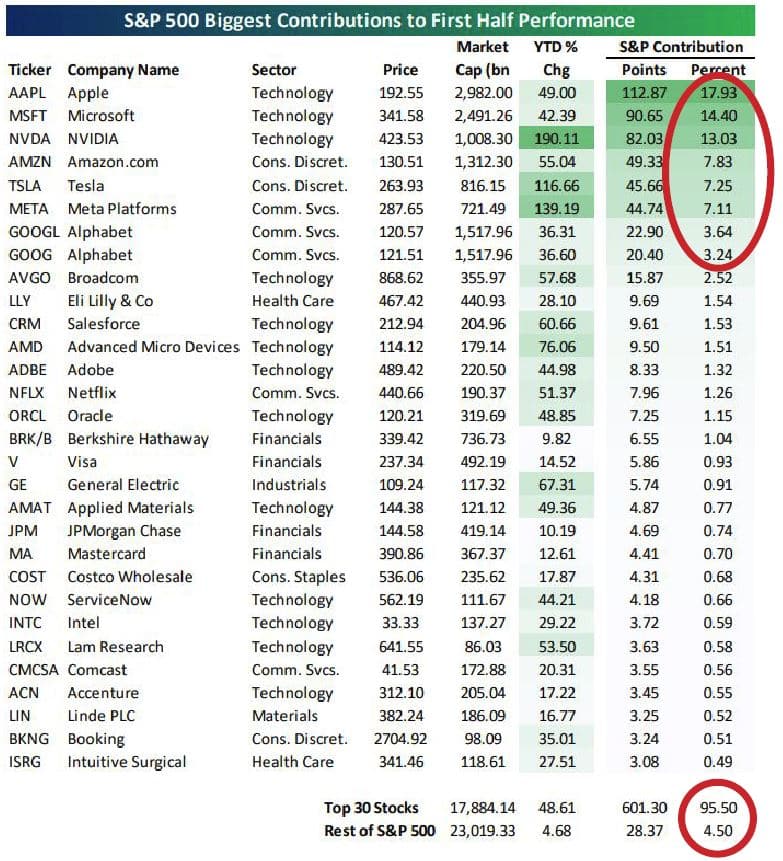
Much ink has been spilled in the futile pursuit of predicting when the next recession will begin and how deep it will be. We don’t play that game, but note every economic expansion has been followed by a recession, just as every recession has been followed by an economic expansion. Further, the next recession will be one of the most widely expected/anticipated in recent memory. Short-term yields ended Q2-2023 well above long-term yields for the fifth quarter in a row. When short-term U.S. Treasury yields exceed long-term yields, it’s known as an “inverted yield curve,” a sign investors are pessimistic about the economy. An inverted yield curve has preceded every recession, but not every inversion has been followed by a recession. Every salmon is a fish, but not every fish is a salmon. Further, the Conference Board’s index of Leading Economic Indicators has declined for 14 straight months (the third longest streak on record and just the fourth streak of twelve or more months), a level that has been associated with recessions in the past.
In our Q3-2022 Client Letter we shared Warren Buffett’s views on economic forecasting and the inevitability of recessions:
According to Warren Buffett, in addition to economists being lousy forecasters, “something different happens all the time. And that’s one reason economic predictions just don’t enter into our decisions. Charlie Munger – my partner – and I in 54 years now never made a decision based on an economic prediction. We make business predictions about what individual businesses will do over time, and we compare that to what we had to pay for them.
“But we have never said “yes” to something because we thought the economy was going to do well in the next year or two years. And we have never said “no” to anything because we were right in the middle of a panic. There are so many variables. I mean, in the hard sciences, you know that if an apple falls from a tree, that it isn’t going to change over the centuries because of anything or political developments or 400 other variables that go in. But when you get into economics, there’s so many variables, and the truth is, you’ve got to expect good times and bad times in business.”
Buffett buys “great businesses with great managers,” who will be able to succeed during difficult times just as they would during good times. “We’re going to have good years, bad years, in-between years and maybe a disastrous year some year,” he said. “We care a lot about the price. We do not care about the next 12 months.”
For us, this means we invest in businesses, not stock ticker symbols. Although stock prices are driven by fear and greed and are very volatile, the value of the underlying businesses don’t change that much from day-to-day. The businesses we own are profitable now, generate more cash than they consume and generally have “pricing power.” They also generally have “clean” balance sheets with lower-than-average debt levels. We believe stocks of companies with these characteristics will fare much better in an environment of higher inflation/interest rates than those whose eventual profitability is many years down the road (if at all) and were dependent on an endless stream of cheap credit.
Three Investment Lessons Reinforced in the first-half of 2023
- “Experts” are lousy forecasters about the economy and financial markets.
- Surprises happen. Silicon Valley Bank failed on March 10, 2023, the third largest bank failure in U.S. history and largest since the Global Financial Crisis/Great Recession. Many experts predicted a return to those dark days, but the S&P 500 had a total return of 15.8% between March 10, 2023 and June 30, 2023 (meaning almost all of the gain in the first-half of 2023 occurred after Silicon Valley Bank failed).
- It’s best to focus on your plan. Whether it was the panics related to the aforementioned failure of Silicon Valley Bank or the periodic “Sword of Damocles” gamesmanship regarding raising the debt ceiling to prevent a U.S. default, speculators (not investors) had very good reasons to move to cash “until the dust settles.” True to form, these speculators would have missed out on the significant returns earned by investors who stayed the course and stuck to their plans. Remember, your investment decisions and reactions to market events will have a significant impact on your personal investment return.
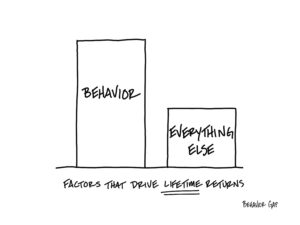
Regards,
Kirr, Marbach & Company, LLC
Past performance is not a guarantee of future results.
The S&P 500 Index is an unmanaged, capitalization-weighted index generally representative of the U.S. market for large capitalization stocks. This index cannot be invested in directly.
The S&P 500 Value Index is an unmanaged, capitalization-weighted index that measures the performance of the value segment of the U.S. market for large-capitalization stocks. This index is a subset of the S&P 500 Index and cannot be invested in directly.
The S&P 500 Growth Index is an unmanaged, capitalization-weighted index that measures the performance of the growth segment of the U.S. market for large-capitalization stocks. This index is a subset of the S&P 500 Index and cannot be invested in directly.









